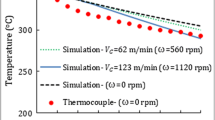Abstract
This study attributed to post treatment of tungsten carbide (WC) inserts using microwave irradiation. Tungsten carbide inserts were subjected to microwave radiation (2.45 GHz) to enhance its performance in terms of reduction in tool wear rate, cutting force surface roughness and improvement in tool life. Performance of tungsten carbide insert is very much affected by machine operating parameters i.e. speed, feed and depth of cut. An attempt has been made to investigate the effects of machining parameters on microwave treated tool inserts. This paper describes the comparative study of machining performance of untreated and microwave treated WC tool inserts used for turning of AISI 1040 steel. Machining performance has been evaluated in terms of flank wear, cutting force, surface roughness, tool wear mechanisms. Critical examinations of tool wear mechanisms and improvements in metallurgical properties such as microstructural change, phase activation of WC grains were identified using scanning electron microscope (SEM). Results obtained from the turning using the microwave treated tool inserts showed a significant reduction tool wear thereby enhancing the surface quality of workpiece.
Similar content being viewed by others
References
E. M. Trent and P. K. Wright, Metal cutting, 4th Ed., Elsevier, Woburn, USA (2000).
Y. S. VaradaRajan et al., Performance enhancement through microwave irradiation of K20 carbide tool machining Al/SiC metal matrix composite, J. Mater. Process. Technol., 173 (2) (2006) 185–193.
J. Ramkumar et al., Enhancing the metallurgical properties of WC insert (K-20) cutting tool through microwave treatment, Mater. Lett., 53 (3) (2002) 200–204.
D. El Khaled et al., Microwave dielectric heating: Applications on metals processing, Renew. Sustain. Energy Rev., 82 (December 2016) (2018) 2880–2892.
A. Aguilar-Reynosa et al., Microwave heating processing as alternative of pretreatment in second-generation biorefinery: An overview, Energy Convers. Manag., 136 (2017) 50–65.
J. P. Cheng, Study on microwave sintering technique of ceramics materials, Ph.D. Thesis, China Wuhan University of Technology, Wuhan, China (1991).
D. E. Clark, D. C. Folz and J. K. West, Processing materials with microwave energy, Mater. Sci. Eng. A, 287 (2) (2000) 153–158.
S. Aravindan and R. Krishnamurthy, Joining of ceramic composites by microwave heating, Mater. Lett., 38 (4) (1999) 245–249.
S. Chandrasekaran, T. Basak and R. Srinivasan, Microwave heating characteristics of graphite based powder mixtures, Int. Commun. Heat Mass Transf., 48 (2013) 22–27.
E. Breval et al., Comparison between microwave and conventional sintering of WC/Co composites, Mater. Sci. Eng. A, 391 (1-2) (2005) 285–295.
J. Ramkumar, S. K. Malhotra and R. Krishnamurthy, Effect of microwave treatment on Wc inserts for drilling of Gfrp composites, Mach. Sci. Technol., 9 (2) (2005) 263–269.
S. R. Das, D. Dhupal and A. Kumar, Study of surface roughness and flank wear in hard turning of AISI 4140 steel with coated ceramic inserts, J. Mech. Sci. Technol., 29 (10) (2015) 4329–4340.
H. S. Jung, Environmentally conscious hard turning of cemented carbide materials on the basis of micro-cutting in SEM (2nd report): Stress turning with three kinds of cutting tools, J. Mech. Sci. Technol., 23 (7) (2009) 1959–1966.
A. Krawitz and E. Drake, Residual stresses in cemented carbides -An overview, Int. J. Refract. Met. Hard Mater., 49 (1) (2015) 27–35.
S. V. Telrandhe, A. K. Saxena and S. Mishra, Effect of microstructure and cutting speed on machining behavior of Ti6Al4V alloy, J. Mech. Sci. Technol., 31 (5) (2017) 2177–2184.
Author information
Authors and Affiliations
Corresponding author
Additional information
Durwesh Jhodkar is a Ph.D. student in Mechanical Engineering Discipline at PDPM IIITDM, Jabalpur, India. He received his Masters of Engineering degree in Industrial Engineering and Management from SGSITS, Indore (India) in year 2010. His area of interest is Advance machining process, Post treatment analysis, Cutting tool condition monitoring, Lean manufacturing.
H Chelladurai is currently a Assistant Professor in Mechanical Engineering Discipline at PDPM IIITDM, Jabalpur. He received his Ph.D. in Mechanical Engineering from Indian Institute of Technology, Kanpur (India). His current research area of interest include Advance manufacturing, Micro-fabrication, Tool condition monitoring, IC Engines, Welding technology.
Rights and permissions
About this article
Cite this article
Jhodkar, D., Amarnath, M., Chelladurai, H. et al. Performance assessment of microwave treated WC insert while turning AISI 1040 steel. J Mech Sci Technol 32, 2551–2558 (2018). https://doi.org/10.1007/s12206-018-0512-2
Received:
Revised:
Accepted:
Published:
Issue Date:
DOI: https://doi.org/10.1007/s12206-018-0512-2




